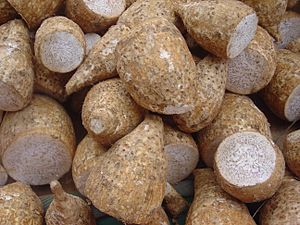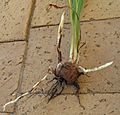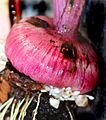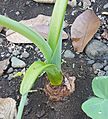Corm facts for kids
A corm, bulbo-tuber, or bulbotuber is a short, vertical, swollen underground plant stem that serves as a storage organ used by some plants to survive winter or other adverse conditions such as summer drought and heat (perennation).
The word cormous is used to describe plants growing from corms, in analogy to the use of the terms "tuberous" and "bulbous" to describe plants growing from tubers and bulbs.
Corms can be dug up and used to propagate or redistribute the plant (see, for example, taro). Plants with corms generally can be propagated by cutting the corms into sections and replanting. Suitably treated, each section with at least one bud usually can generate a new corm.
Images for kids
-
Crocosmia corm with stolons emerging through the tunic. The stolons originate at the axillary buds of the corm scales, and generally produce new corms at their tips
-
Gladiolus corm, showing the formation of small cormels at the ends of short stolons
-
Corm on Alocasia macrorrhizos
See also
 In Spanish: Cormo para niños
In Spanish: Cormo para niños







